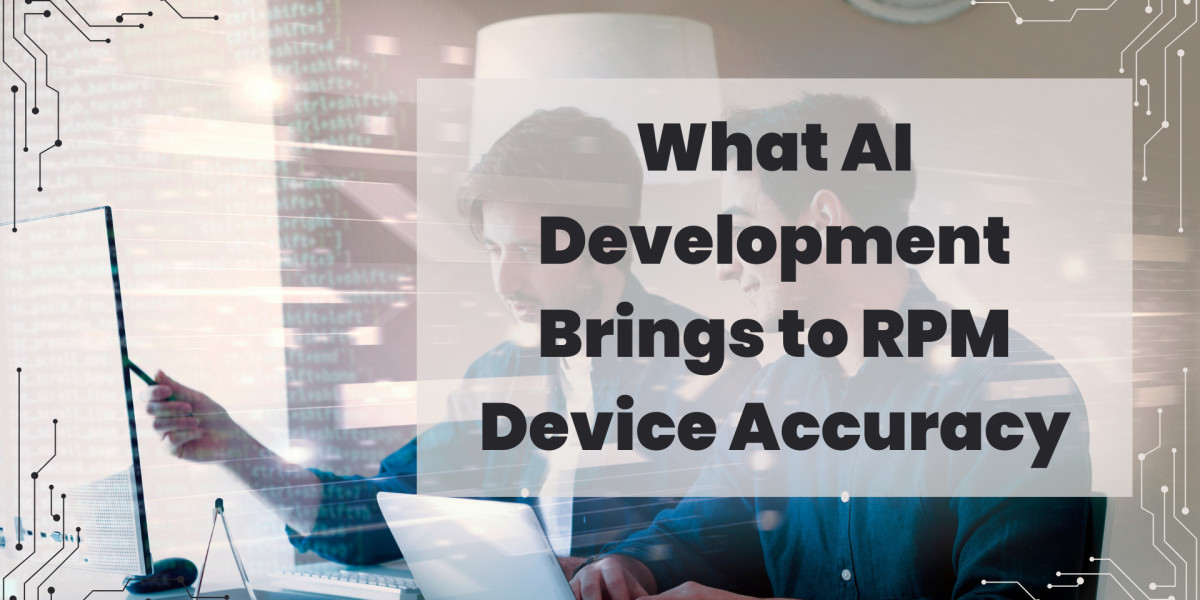Remote Patient Monitoring (RPM) is no longer a futuristic concept—it’s the present reality of modern medicine. Hospitals, clinics, and home-care providers across the world rely on digital devices that track vital signs and transmit them in real time.
But here’s the uncomfortable truth: accuracy remains a persistent challenge. A device can only be as reliable as the intelligence guiding it. And that’s exactly where Artificial Intelligence (AI) changes the game.
AI development doesn’t just make RPM devices smarter—it makes them more precise, adaptive, and clinically valuable. For healthcare leaders and technology innovators, understanding how AI enhances accuracy isn’t just technical insight—it’s strategic foresight.
The New Frontier of Remote Patient Monitoring
RPM sits at the intersection of healthcare delivery and digital transformation. It allows patients to be monitored beyond hospital walls—through wearables, biosensors, and connected medical devices.
From chronic disease management to post-surgical care, RPM bridges the gap between clinic and home. But its impact hinges on one fundamental factor: accuracy.
A slightly inaccurate blood pressure reading can alter a diagnosis.
A missed oxygen desaturation can delay intervention.
A false alert can overwhelm clinicians and cause alarm fatigue.
Precision isn’t a luxury—it’s the foundation of trust between technology and medicine. And that’s precisely why AI has become the cornerstone of next-generation RPM.
Why Accuracy Matters More Than Ever
For healthcare executives, the difference between an accurate and inaccurate device is the difference between efficiency and liability.
Clinical Impact
Inaccurate data leads to misdiagnosis, delayed interventions, and reduced clinical confidence. Every false negative or false positive erodes the reliability of the monitoring ecosystem.
Financial Impact
Hospitals investing in RPM infrastructure expect returns through reduced readmissions and optimized care delivery. Poor data integrity increases costs through repeated testing and manual validation.
Reputational Impact
In a competitive digital health landscape, credibility depends on precision. AI-driven accuracy enhances brand trust—something both providers and patients deeply value.
How AI Transforms RPM Device Accuracy
AI’s contribution to accuracy is multifaceted. It refines every stage of the monitoring process—from signal collection to data interpretation.
1. Signal Filtering and Noise Reduction
Real-world data is messy. Motion artifacts, sensor drift, environmental interference—these are everyday hurdles for RPM systems.
AI algorithms, particularly deep learning and adaptive filtering, can distinguish genuine physiological signals from noise in real time.
Example: A wearable ECG patch records heart signals, but movement or sweat introduces noise. A convolutional neural network (CNN) trained on thousands of signal variations filters out irrelevant distortions—leaving a clean, medically interpretable waveform.
AI, in this sense, becomes the “ear” that hears the true rhythm beneath the static.
2. Adaptive Calibration
Traditional RPM devices depend on manual calibration—often impractical for continuous monitoring. AI introduces dynamic calibration, learning from user-specific patterns.
If a patient’s baseline oxygen saturation normally fluctuates slightly during sleep, the system learns this behavior and adjusts thresholds accordingly.
Over time, the device becomes attuned to the individual, not just the population average.
This personalization minimizes false alerts and improves clinical relevance.
3. Predictive Error Correction
AI models can identify and correct likely measurement errors before data reaches clinicians. Using predictive analytics, the system cross-references real-time readings with historical trends to flag outliers that defy physiological logic.
For example, if a patient’s heart rate suddenly jumps from 75 bpm to 180 bpm without corresponding changes in oxygen or motion data, the algorithm flags it as a probable measurement error, not a medical emergency.
4. Sensor Fusion
Modern health tracking involves multiple sensors—heart rate, blood pressure, temperature, oxygen levels, glucose monitoring, motion detection, etc.
AI integrates (or “fuses”) these data streams to create a cohesive and corroborated reading. This cross-verification dramatically improves accuracy because anomalies are validated through multiple indicators rather than a single sensor.
In technical terms, AI acts as a consensus engine, ensuring reliability through multi-sensor correlation.
5. Continuous Learning and Model Evolution
Unlike static algorithms, AI models evolve. Each new dataset—each new patient, device, and environment—helps refine the predictive model.
This feedback-driven intelligence is what gives AI its adaptive edge. The longer the system operates, the more accurate it becomes.
6. Contextual Awareness
Perhaps AI’s most understated contribution is contextual intelligence. It doesn’t just process numbers; it interprets circumstances.
It distinguishes between an elevated heart rate from physical activity and one triggered by stress.
It correlates oxygen fluctuations with altitude changes during travel.
It understands time of day, sleep patterns, and medication schedules.
By embedding contextual reasoning, AI ensures that every alert carries meaning—not just data.
Inside the Architecture of AI-Enhanced RPM Devices
Building AI-enabled accuracy into RPM systems requires an end-to-end design strategy. Here’s how it unfolds:
Data Acquisition
RPM devices capture continuous signals—vital signs, movement, speech, and more. The quality of data depends on sensor sensitivity, sampling rate, and environment calibration.
Edge Processing
To ensure responsiveness, initial AI computations often occur at the “edge”—within the device itself. This reduces latency and allows immediate filtering or error detection.
Cloud Integration
Processed data streams are then transmitted securely to the cloud, where deeper AI models analyze longitudinal trends and cross-patient correlations.
Predictive Modeling
Machine learning algorithms, such as LSTM (Long Short-Term Memory) networks, identify temporal dependencies in physiological data. This enables early detection of anomalies that could otherwise go unnoticed.
Visualization and Feedback
Dashboards convert AI insights into actionable intelligence. Clinicians can see patterns across thousands of patients, while individuals receive clear feedback on their own metrics.
The result? A continuous learning loop where devices don’t just collect data—they learn from it.
The Science of Accuracy: AI in Numbers
AI’s impact on RPM accuracy isn’t speculative—it’s measurable.
Heart Rate Monitoring: AI signal processing can reduce noise-related errors by up to 40%, improving ECG accuracy across wearable devices.
Blood Pressure Monitoring: Machine learning algorithms trained on diverse populations improve systolic/diastolic accuracy by nearly 15%.
Oxygen Saturation: AI-enhanced SpO₂ sensors achieve accuracy within ±1% of traditional clinical-grade pulse oximeters.
Glucose Monitoring: Predictive modeling reduces false alerts in continuous glucose monitors by up to 30%.
These improvements translate into fewer misreads, fewer false alarms, and greater physician confidence in remote data.
Case Study: AI in Chronic Care RPM
Consider a large healthcare network managing thousands of cardiac patients remotely. Their challenge: inconsistent ECG readings leading to false-positive alerts.
After integrating AI-based noise filtering and adaptive thresholds, the system achieved:
35% reduction in false positives
20% improvement in early anomaly detection
28% faster clinical response time
These aren’t just efficiency gains—they represent lives saved and operational costs reduced.
Challenges in AI-Driven Accuracy Enhancement
While AI brings unprecedented precision, it also introduces new challenges. C-level leaders should understand these before implementation.
Data Diversity and Bias
AI models are only as unbiased as their training data. If datasets underrepresent certain demographics or conditions, predictions may skew.
Solution: Build diverse, representative datasets through multi-institutional collaborations.
Regulatory Complexity
AI-enhanced RPM devices fall under medical device regulations, requiring rigorous validation and FDA or EMA approvals. Continuous learning systems must document algorithmic changes transparently.
Ethical and Privacy Concerns
Health data is intensely personal. Ensuring compliance with HIPAA, GDPR, and emerging AI ethics guidelines is non-negotiable.
Integration Overload
Hospitals already juggle multiple digital systems. Seamless integration of AI RPM platforms into existing EHRs and workflows is crucial for adoption.
Human Trust
AI should assist clinicians, not replace them. Clear explainability and transparency in how AI arrives at conclusions help preserve medical trust.
The Strategic Benefits of AI Accuracy for Organizations
For Healthcare Providers
Clinical Reliability: AI-verified data enhances diagnostic confidence.
Operational Efficiency: Fewer false alerts reduce staff workload and burnout.
Improved Outcomes: Early detection means faster interventions and fewer complications.
For Device Manufacturers
Competitive Differentiation: AI-enhanced accuracy becomes a key market advantage.
Regulatory Leverage: Demonstrable accuracy supports faster approvals and reimbursements.
Product Evolution: AI insights fuel continuous device improvement.
For Insurers and Payers
Data Integrity: Reliable readings improve claim validation and fraud detection.
Preventive Care ROI: Accurate tracking lowers hospitalization and treatment costs.
The Future of RPM: Precision Without Compromise
As AI evolves, RPM devices are moving toward clinical-grade precision in non-clinical environments. The next generation of systems will rely on emerging technologies that push accuracy even further.
Federated Learning
AI models will train on decentralized datasets without moving sensitive patient information, improving both accuracy and privacy simultaneously.
Self-Calibrating Devices
Sensors will use AI-driven calibration to self-correct in changing environments—adapting to humidity, temperature, or skin tone variations in real time.
Multimodal Health Analysis
AI will fuse voice, motion, and biomarker data into holistic models that detect early disease signals long before traditional metrics do.
Explainable AI (XAI)
To meet regulatory and ethical standards, next-gen RPM platforms will include transparent AI models that explain why a reading was flagged or adjusted.
Edge AI and 5G Synergy
Faster networks and smarter devices mean real-time accuracy validation at the point of care—no lag, no loss, just precision.
Executive Playbook: What Leaders Should Focus On
For C-suite executives strategizing their AI health initiatives, these priorities can guide the path forward:
Invest in Data Integrity: Quality data is the backbone of accurate AI. Partner with clinical institutions to source validated datasets.
Prioritize Algorithm Transparency: Ensure models can explain their decisions to clinicians and regulators alike.
Plan for Continuous Validation: Establish audit trails and retraining mechanisms to maintain model performance.
Champion Interoperability: Design systems that integrate seamlessly across EHRs, wearables, and third-party devices.
Build Ethical Frameworks: Embed fairness, accountability, and privacy into AI governance from day one.
AI in RPM is not just a technical asset—it’s a strategic differentiator that defines leadership in healthcare innovation.
A Glimpse into the Next Decade
By 2035, AI-driven remote monitoring will no longer be an optional tool—it will be the primary interface between patients and healthcare systems.
Hospitals will monitor discharged patients remotely with near-zero error margins.
AI models will predict health deterioration days before symptoms emerge.
Patients will manage chronic conditions from home with confidence in device accuracy rivaling hospital-grade equipment.
This isn’t a distant vision—it’s a roadmap already unfolding in progressive healthcare ecosystems across the globe.
Conclusion
AI has redefined what accuracy means for Remote Patient Monitoring. It filters noise, learns patient patterns, and delivers clinically reliable insights in real time. The result is not just better technology—but better care, deeper trust, and smarter decision-making across the healthcare continuum.
For organizations aiming to lead in digital health transformation, collaborating with specialized experts in AI software development services ensures that every RPM device built or deployed meets the gold standard of precision, compliance, and performance.



